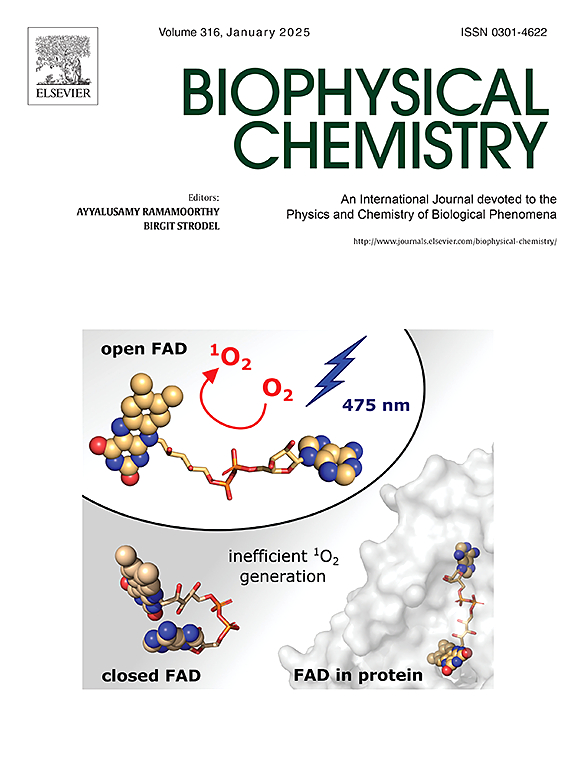Heliotropium Bacciferum的酚类组分抑制人胰岛素聚集和防止淀粉样蛋白诱导的细胞毒性:结构和生物物理分析
IF 2.2
3区 生物学
Q2 BIOCHEMISTRY & MOLECULAR BIOLOGY
引用次数: 0
摘要
在人类中,有50多种疾病与蛋白质纤颤有关,包括阿尔茨海默病和帕金森病。使用天然产物抑制淀粉样蛋白纤维的形成是预防这些疾病进展的主要治疗策略之一。在这种情况下,从Heliotropium bacciferum叶片中提取的酚类提取物被评估其抑制人胰岛素(HI)聚集的能力,HI是生理条件下纤维性颤动的合适模型蛋白,在600转/分的搅拌下。我们的研究结果显示,在研究条件下,HI纤颤的聚集动力学符合s型曲线,其标志和kapp值分别为44.4 h和0.16 h−1。通过8-苯胺-1-萘磺酸(ANS)探针检测纤维形成前的结构变化,发现HI肽中的疏水区暴露于溶剂中,其标记值和kapp值分别为18.2 h 0.12 h−1。CD谱计算出形成的原纤维由51.6%的β片结构和43.0%的无序结构组成。体外研究表明,芽孢杆菌提取物对HI纤颤有剂量依赖性的抑制作用。200 μg/mL的游离酚组分(FPF)表现出几乎完全的抑制作用,而结合酚组分(BPF)显示出52%的纤颤减少。使用瑞利光散射(RLS)和圆二色性分析进一步验证了这些发现。透射电镜(TEM)证实了胰岛素纤颤的形成及其提取物的抑制作用。此外,SH-SY5Y细胞的MTT实验结果显示,两种提取物都以剂量依赖的方式减弱了HI原纤维诱导的神经元毒性。此外,RT-PCR分析显示,低浓度(7.8 μg/mL) H. bacciferum提取物共处理SH-SY5Y细胞后,促凋亡基因Casp3和Bax的表达水平显著降低,抗凋亡基因Bcl-2的表达水平显著升高。本研究强调了芽孢杆菌提取物作为治疗蛋白纤颤相关疾病的潜力,并强调了多酚在预防淀粉样纤维形成中的重要性。本文章由计算机程序翻译,如有差异,请以英文原文为准。

Phenolic fractions of Heliotropium Bacciferum inhibit human insulin aggregation and protect against amyloid-induced cytotoxicity: Structural and biophysical analysis
In humans, more than 50 diseases are related to protein fibrillation, including Alzheimer's and Parkinson's diseases. Inhibition of amyloid fibril formation using natural products is one of the main therapeutic strategies for preventing the progression of these diseases. In this context, phenolic extract fractions from Heliotropium bacciferum leaves were evaluated for their ability to inhibit the aggregation of human insulin (HI), an appropriate model protein for fibrillation under physiological conditions and agitation at 600 rpm. Our results exhibited HI fibrillation under studied conditions, with aggregation kinetic fitting a sigmoidal curve with and values of 44.4 h and 0.16 h−1, respectively. Structural changes preceding the onset of fibril formation were detected by 8-Anilino-1-naphthalene-sulphonic acid (ANS) probe, revealed the exposure of hydrophobic regions in the HI peptide to the solvent, with and values of 18.2 h 0.12 h−1, respectively. CD spectroscopy calculated the formed fibrils comprised of 51.6 % β-sheet structure and 43.0 % unordered structure. In vitro studies demonstrated a dose-dependent inhibitory effect of H. bacciferum extracts on HI fibrillation. The free phenolic fraction (FPF) at 200 μg/mL exhibited nearly complete inhibition, whereas the bound phenolic fraction (BPF) demonstrated a 52 % reduction in fibrillation. These findings were further validated using Rayleigh light scattering (RLS) and circular dichroism analyses. Transmission electron microscopy (TEM) validated the formation of insulin fibrillation and its inhibition by extract fractions. Moreover, MTT assay results on SH-SY5Y cells showed that both extract fractions attenuated HI fibril-induced neuronal toxicity in a dose-dependent manner. Furthermore, RT-PCR analysis revealed that co-treatment with a low concentration (7.8 μg/mL) of H. bacciferum extracts led to a significant reduction in the expression levels of pro-apoptotic genes (Casp3 and Bax) and an increase in the anti-apoptotic gene Bcl-2 in SH-SY5Y cells treated with fibrillated HI. This study highlights the potential of H. bacciferum extracts as therapeutic agents against protein fibrillation-related diseases and underscores the importance of polyphenols in preventing amyloid fibril formation.
求助全文
通过发布文献求助,成功后即可免费获取论文全文。
去求助
来源期刊

Biophysical chemistry
生物-生化与分子生物学
CiteScore
6.10
自引率
10.50%
发文量
121
审稿时长
20 days
期刊介绍:
Biophysical Chemistry publishes original work and reviews in the areas of chemistry and physics directly impacting biological phenomena. Quantitative analysis of the properties of biological macromolecules, biologically active molecules, macromolecular assemblies and cell components in terms of kinetics, thermodynamics, spatio-temporal organization, NMR and X-ray structural biology, as well as single-molecule detection represent a major focus of the journal. Theoretical and computational treatments of biomacromolecular systems, macromolecular interactions, regulatory control and systems biology are also of interest to the journal.
 求助内容:
求助内容: 应助结果提醒方式:
应助结果提醒方式:


